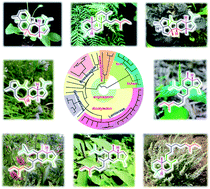The untapped potential of plant sesterterpenoids: chemistry, biological activities and biosynthesis†
Abstract
Covering: 1969 up to 2021
Sesterterpenoids, biosynthetically derived from the precursor, namely geranylfarnesyl diphosphate (GFDP) are amongst the rarest of all isoprenoids with approximately 1300 compounds known. Most sesterterpenoids originate from marine organisms (especially sponges), while only about 15% of these compounds are isolated from several families of plants such as Lamiaceae, Gentianaceae, and Nartheciaceae. Many plant sesterterpenoids possess highly oxygenated and complex cyclic skeletons and exhibit remarkable biological activities involving cytotoxic, anti-inflammatory, antimicrobial, and antifeedant properties. Thus, due to their intrinsic chemical complexity and intriguing biological profiles, plant sesterterpenoids have attracted continuing interest from both chemists and biologists. However, the biosynthesis and distribution of sesterterpenoids in the plant kingdom still remain elusive, although substantial progress has been achieved in recent years. This review provides an overall coverage of sesterterpenoids originating from plant sources, followed by a classification of their chemical skeletons, which summarizes the distribution, chemistry, biological activities, biosynthesis and evolution of plant sesterterpenoids, aiming at strengthening the research efforts toward the untapped great potential of these unique natural product resources.



 Please wait while we load your content...
Please wait while we load your content...